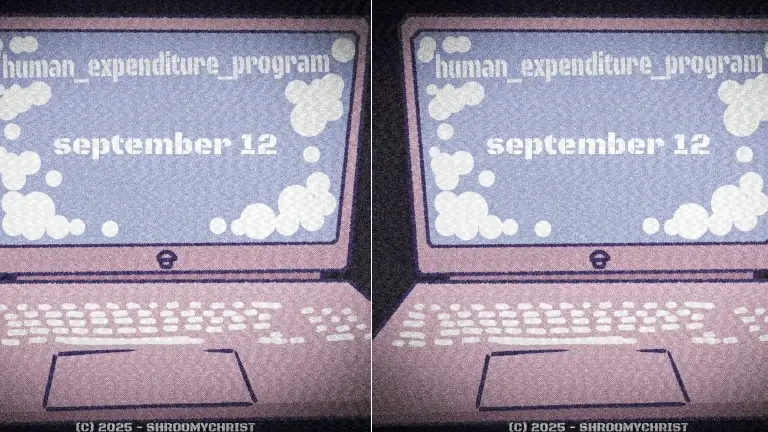

Favourite Games
Human Expenditure Program

Human Expenditure Program – A Full Exploration of a Disturbing Interactive Experiment
Human Expenditure Program is an indie game that blends simulation, narrative, and moral choice into one unsettling package. Developed by ShroomyChrist Studios and sometimes referred to as BloodMoney 2, it puts the player in charge of Harvey Harvington, an ordinary man who becomes the subject of a mysterious “program.” At first, it seems like the game belongs to the same family as pet simulators or casual care games, but it quickly reveals itself to be something much darker. Instead of taking care of a dog, cat, or virtual creature, the player is responsible for the survival of a human being, and every choice directly influences how the story unfolds.
This is not just another experiment in idle mechanics or choice-driven storytelling. BloodMoney 2 uses simplicity as a weapon. It invites the player into a routine that feels familiar, then gradually exposes the weight of every decision. What begins as small acts of feeding and interacting with Harvey develops into a moral struggle where you must decide how far you are willing to go, and at what cost.
Setting and Premise
The game places the player in a confined scenario where Harvey is the centerpiece. You do not control a wide world, nor do you have dozens of characters to manage. There is only Harvey, and the system that governs his existence. The “program” referenced in the title becomes a metaphor for control, surveillance, and expenditure of human life. It is deliberately vague, leaving players to interpret what the program truly is. Is it a scientific trial? A corporate project? A metaphor for society at large? The lack of clarity is intentional, forcing players to focus less on external lore and more on the direct consequences of their actions.
Gameplay Mechanics
On a mechanical level, Human Expenditure Program looks straightforward. You interact with Harvey through simple actions: feeding him, talking to him, giving him items, or making him participate in small minigames. These actions may feel ordinary at first, but the underlying systems ensure that they are never meaningless.
The game’s core mechanics can be broken down into several layers:
- Basic Care – Harvey must eat and rest, and neglecting these needs has visible consequences.
- Minigames and Events – The player is sometimes thrown into interactive challenges where timing or choice determines success.
- Memory System – Harvey remembers. If you mistreat him, ignore him, or force him into certain actions, he will not forget. Later interactions change depending on what has already happened.
- Branching Endings – There are multiple possible conclusions to the program, and which one you see depends on your choices.
This combination ensures that the player feels pressure.
Harvey Harvington – The Human Core
At the heart of the game is Harvey himself. Unlike pets or abstract characters in other simulators, Harvey is designed to feel real enough to make you uncomfortable. He is voiced, animated, and responsive. His reactions vary depending on what you do, and this creates a strong sense of presence.
When you feed him properly, he may thank you or show signs of trust. When you mistreat him, his responses shift—sometimes quiet resignation, sometimes visible distress. This spectrum of reactions makes him less like a character in a game and more like a participant in an experiment you are conducting.
The fact that Harvey is not an animal but a man is what gives the game its power. It directly confronts the player with the dehumanization often hidden in systems of control and management.
Features That Define the Experience
BloodMoney 2 is not expansive in scope, but its small set of features is carefully designed to maximize impact. Some of the defining aspects include:
- Interactive care system: feeding, resting, and managing Harvey’s needs.
- Narrative consequences: every choice adds to a branching storyline.
- Memory tracking: Harvey remembers past actions, making the player feel long-term accountability.
- Multiple endings: at least two main endings exist, with hidden variations depending on decisions.
- Voice acting: Harvey is voiced by Dexter Manning, giving his reactions authenticity.
- Atmospheric tension: light moments are undercut by the constant reminder of irreversible choices.
These features combine to create a game that is less about skill and more about reflection.
The Role of Consequences
What sets Human Expenditure Program apart from casual simulation games is how it treats consequences. In many games, poor decisions can be undone, progress can be reloaded, and mistakes are temporary. Here, the memory system prevents easy erasure. Harvey does not forget. If you fail to feed him, ignore his needs, or force him through traumatic situations, that decision echoes in later stages.
This structure forces players to confront their own responsibility. It is no longer possible to treat the character as a disposable resource. Harvey’s memory makes every action permanent in narrative terms, and that permanence builds tension.
The Endings
The game features multiple endings, which reflect the player’s treatment of Harvey and the path chosen through the program. While not every ending is publicly documented, players have reported at least two distinct outcomes, often labeled as “good” and “bad.” The good ending usually results from consistent care, empathy, and restraint, while the bad ending arises from neglect, exploitation, or indifference.
However, these endings are not simplistic. Even the so-called good ending carries an uneasy atmosphere, as if the very act of participating in the program has already tainted the result. The bad ending, on the other hand, is a stark reminder of how easily human life can be reduced to data and discarded when systems are designed without empathy.
Themes and Symbolism
The BloodMoney 2 is not just about interaction with one man. It is loaded with themes and metaphors that resonate far beyond the screen.
Some of the most striking include:
- Exploitation of labor – Harvey represents any individual caught in a system that views people as expendable resources.
- Surveillance and control – The “program” acts as a metaphor for systems that monitor and regulate human life without concern for individuality.
- Responsibility and complicity – The player is not a passive observer. Every click, every choice, makes them complicit in Harvey’s fate.
- Memory and trauma – By ensuring that Harvey remembers, the game mirrors the lasting effects of trauma and the impossibility of erasing harm.
These themes elevate the game from simple simulation to commentary.
The Horror of Reflection
Human Expenditure Program is often described as horror, but not in the traditional sense. There are no monsters chasing you, no jump scares, no haunted mansions. The horror lies in recognition—the realization that you are participating in the reduction of a human life to mechanics.
This subtle form of horror is psychological. It asks the player to confront why they keep playing. Why do they continue clicking, choosing, and experimenting, even when they know it harms Harvey? The unease grows not from external threats but from internal conflict.
Comparison to Other Games
It is tempting to compare BloodMoney 2 to other simulation or moral-choice games, but its uniqueness becomes clear in comparison.
- Unlike pet simulators, it does not allow players to escape into cuteness. The subject is human, which adds weight.
- Unlike idle clickers, it is not about endless growth or exponential numbers. Every gain feels like a loss for Harvey.
- Unlike narrative adventures, it embeds story in mechanics, not long dialogue trees. The story emerges from how you treat Harvey.
In this way, the game occupies a strange but fascinating middle ground.
Player Strategies and Experiences
Because the game allows for multiple endings, players experiment with different strategies. Some play cautiously, always feeding Harvey and trying to minimize harm. Others test the limits, ignoring his needs or pushing him through distress just to see what happens. A few adopt an experimental mindset, replaying the game multiple times to unlock every possible outcome.
This variety of playstyles is part of what makes the game so engaging. Each run becomes not only a test of mechanics but a reflection of the player’s values.
Strengths and Weaknesses
Like any indie project, Human Expenditure Program has both strengths and weaknesses.
Strengths:
- Innovative concept and memorable design.
- Strong use of consequences and memory.
- Effective voice acting that adds emotional depth.
- Replayability due to multiple endings.
Weaknesses:
- Limited variety of mechanics beyond core interactions.
- Short length compared to traditional narrative games.
- Some players may miss the deeper message if they focus only on experimenting with outcomes.
Despite these weaknesses, the game succeeds in leaving a lasting impression.
BloodMoney 1
BloodMoney is an indie game that places the player in control of a morally complex experiment, where managing resources is tied directly to the life of a central character. Instead of focusing on traditional combat or exploration, the game presents a confined scenario in which every choice has visible consequences. The design emphasizes responsibility, memory, and the unsettling realization that progress often comes at the expense of human well-being, turning simple interactions into a reflection on control and exploitation.
Final Thoughts
Human Expenditure Program is not for everyone. Some players will find it too simple, too short, or too unsettling. But for those who engage with it fully, it offers an experience that lingers. By focusing on Harvey Harvington, a single human character, and by building a system where every action matters, it delivers commentary on exploitation, responsibility, and the cost of progress.
Discuss Human Expenditure Program


















